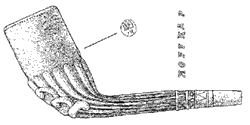No. 10/1997, p. 1-51
Bernd Standke: Clay-pipe production in Grimma, Saxony
First, a critical review is given of the relevant information in
18th and 19th century technological literature, which documents
the economic importance of clay-pipe production for the town of
Grimma. Production started here at the end of the 17th century and
continued until the middle of the 19th century. Many groups of finds
and individual finds in Grimma are described for the first time.
|

Pipe with heel, product of pipe maker
Johann Gottfried Gräfe in Grimma,
end of 18th century
|
|
They are predominately from local factories; some can be
ascribed to individual pipe makers. It is possible with the
help of lists of inhabitants to determine the locations of
the pipe factories in the town. A kiln that was used for firing
clay pipes has already been excavated but at this stage can
only be mentioned, since the institution responsible for the
excavation has not completed their evaluation of the material
found at the dig. Imports from the Netherlands or German towns
other than Grimma seem to be rare amongst the finds. The material
reflects the clay-pipe production of this centre within the
period mentioned above, and this will assist in determining
the provenance of certain fragments found elsewhere.
|
|
|
No. 10/1997, p. 51-56
Walter Morgenroth: A pipe bowl of "siderolith"
A pipe bowl or stub-stemmed pipe is described that is made from
brown coloured clay similar in appearance to the fine earthenware
developed by Josiah Wedgwood in England. In view of the inscription
"13 Leyhn" on the neck of the bowl, the pipe can be ascribed
to the earthenware factory of Philipp Eugenius Leyhn in Pirna, Saxony.
It was probably produced around 1830. In 1812, Leyhn obtained a
concession to manufacture tobacco pipes in Wermsdorf. In 1815 he
established a larger ceramics factory in Pirna and produced mainly
pipe bowls of fine earthenware, which could be made in any of a
variety of colours. Characteristic is the mostly unglazed, finely
grained and often varnished surface. Products made of this material,
which closely resembles fine earthenware, was marketed under the
name "siderolith". The Schiller & Gerbing ceramics
factory established in 1829 in Bohemia used this name for their
products and also manufactured tobacco pipes of coloured earthenware,
which are often mistaken for Turkish pipe bowls or stub-stemmed
pipes.
|
|
Pipe with heel,
back of bowl marked WS
(Weissenspring ?),
end of 18th century
|
No. 10/1997, p. 56-59
Uwe Fiedler: Two pipe bowls and a stem fragment from Lebus on the
R. Oder
Excavations in Lebus yielded fragments of 18th century clay pipes,
which may originate from the Prussian pipe factory at Rostin. However,
it is more likely that they were imported from Weissenspring, which
is mentioned in the inscription on the stem.
|
|
No. 10/1997, p. 59 ff.
Rüdiger Articus: Pipes from Altona
A number of clay-pipe fragments have now been found to support documentary
evidence that pipe makers worked in Altona. Two pipe stems bear
inscriptions stating the name of the pipe maker, who started clay-pipe
making in Altona in 1777, and other stems only bear the place name.
However, several unnamed pipe bowls with a typical decoration can,
by comparison with named fragments, be identified as products from
Altona.

Clay pipe made by Johann Jakob Hoffkamp in Altona,
last quarter of 18th century
|

|
|
|
No. 10/1997, p. 63-66
Zacharias Conrad von Uffenbach : Remarkable Journeys
Zacharias Conrad von Uffenbach (1683-1734), a Frankfurt patrician, undertook
several journeys through Germany and the neighbouring countries at the
beginning of the 18th century. In the account of his travels, which
was published posthumously, he describes a most unusual smoking apparatus
that be saw in December 1709 in Helmstedt in the collection of curiosities
belonging to an abbot by the name of Schmidt.
|
|
